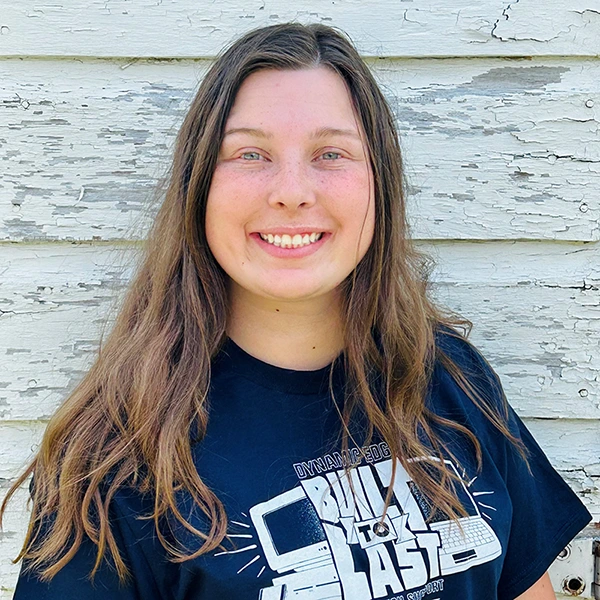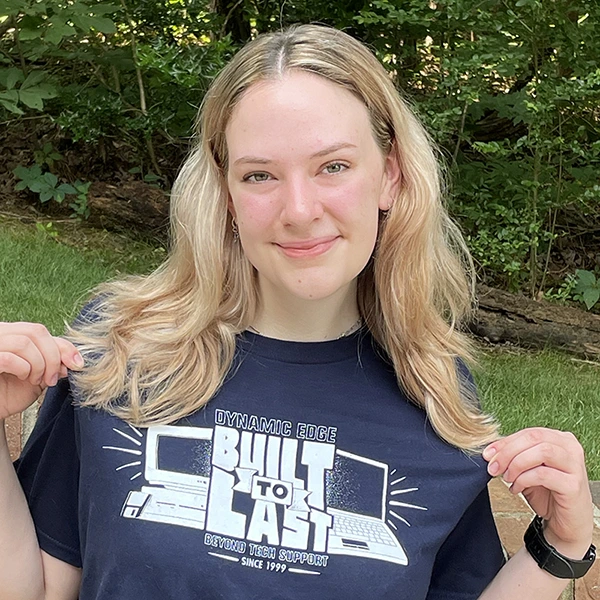
Dynamic Edge is proud to announce the winners of its 2023 Women in STEM Scholarship essay contest.
Please congratulate Allison Prentice of Brandon Township, MI and Bailey (Kat) Johnson of Cleveland, TN! Dynamic Edge awarded $2,000 each to Allie and Kat.
In its third year, the annual Dynamic Edge Women in STEM Scholarship awards cash to two women (one in Michigan and one in Tennessee) who plan to pursue STEM degrees or certifications. Today’s U.S. STEM workers remain male-dominated. While women comprise nearly half of the workforce, only 27% of the STEM workforce identifies as women.
“It’s an honor to celebrate these promising young students,” says Tim Neiman, CEO of Dynamic Edge. “Gender diversity will pay dividends down the road as many different types of people will be required to solve the most complex challenges.”
For 2023, Dynamic Edge asked applicants to submit an essay on one of two topics: describe their favorite tech invention of the past ten years or describe why or what their goals are as a Dynamic Woman in IT. The contest generated 161 submissions, the largest number in the contest’s tenure.
Allie Prentice graduated from Brandon High School in 2023. An experienced archer, she belonged to both the Archery Club and Junior Olympic Archery Development. She plans to attend Southeastern Illinois College as a dual major in Criminal Justice and Wildlife Management. Allie’s winning essay described What3Words, a proprietary GPS application designed to identify any location on Earth within a space of approximately three meters.
Kat Johnson graduated from Cleveland High School in 2023. A member of the National Honor Society, she also competed in cheerleading and dancing. She plans to attend Duke University this fall as a Computer Science major. Kat’s winning essay described the Event Horizon Telescope and its accomplishment in capturing the first image of a black hole.
At Dynamic Edge, every team member understands the power of positive communication and genuine empathy, resulting in superior client service. In fact, “We Enjoy Helping People” is one of its core values. As a leading IT services provider in Michigan and Tennessee, Dynamic Edge strives to support its local communities in new and innovative ways.
Of the winner’s residences, Tim explains, “We founded the company in Ann Arbor in 1999 and opened our second location in Nashville in 2009. Though we serve clients across the country, it’s always been particularly important to us to serve our local communities. We look forward to receiving even more submissions in 2024.”
Please enjoy the winning essays below:

Allison Prentice
Allison Prentice of Brandon Township, MI
I envision taking STEM into nature where it can be utilized to save the lives of countless people. This will change the way people see and interact with national parks. As a National Park Ranger, I plan on using technology to give people the freedom to explore while knowing they are safe. One such invention that helps accomplish this is using Google Earth to make the world smaller. Chris Sheldrick, Jack Waley-Cohen, Mohan Ganesalingam, and Michael Dent divided the world into 57 trillion squares, three meters by three meters. What3Words was born.
What3Words was built out of necessity to deliver band equipment to different venues and has evolved to save lives. Wrong addresses, streets that do not exist, and confusing GPS coordinates can leave anyone lost. On the side of a mountain, the situation can get scary quickly. It is difficult to get help when the location is unknown. What3Words has developed different ways to use its application based on real situations. If there is a cell phone signal click Find Me and send the 3-word location to the rescue crews. They will know the location within 3 meters by 3 meters. In the National Parks, there are locations without a cell phone signal or WiFi, What3Words has safeguards to help find people. If the sky is visible, the app uses satellites to find the 3-Word location. Enter the 3-Words in compass mode and follow the arrows to the location. You can use the 3-words to navigate to that location using the turn-by-turn navigation app that has been loaded for offline use. The app includes 50 different languages to ensure everyone can understand the words.
The What3Words application is already changing how cities save lives. With What3Words, 911 callers no longer need to struggle with describing their location. Click the Find Me icon and the app generates 3-Words that mark the exact location. By sending the 3-Words to the rescue department, valuable time is saved. The exact location can also help decide what agency to send and what supplies are needed. The equipment needed is different if the location is in the ocean versus the forest. The Los Angeles City Fire Department has saved over 170 lost and injured hikers. What3Words has even helped find people buried in rubble after a tornado once a cell signal was found.
As part of the National Park Services, I hope to change the way we locate lost and injured visitors. This will enable us to quickly get them the help they need and not put rangers in additional danger. The What3Words app has other uses when visiting national parks. These include guiding guests to a location and allowing them to feel confident when moving about the park. This would also assist with getting the application on visitors’ phones. I feel technology such as this is critical to the National Park Services, because it can change the way they operate and make the experience for visitors safer and more enjoyable while not affecting the beauty and national significance of the park itself. As a National Park Ranger in Law Enforcement, I hope to advocate for the safe and responsible use of technology in rescue situations. I believe there is a way to respect people’s privacy and still use technology to save lives. In the United States, we have the infrastructure available through satellites to detect problems and locate victims. However, currently, subscriptions for services and a lack of personal smart technologies are creating inequity in people that can be located and saved.

Kat Johnson
Kat Johnson of Cleveland, TN
For millions of years, humanity has been transfixed by the stars. We gaze endlessly up, searching for meaning in the lights’ patterns. In April 2017, eight telescopes followed this tradition by turning their sights to the same infinitesimal patch of sky. They weren’t looking at the stars, however. They were looking at the 6.5 billion solar mass black hole at the center of the Messier 87 galaxy. This team was the Event Horizon Telescope and they gave humanity its first image of a black hole.
The reason the EHT team was able to accomplish this feat was through a technique called Very Long Baseline Interferometry. Capturing an image of M87*, roughly 53 million light-years away, would require a telescope with a diameter nearly the size of the Earth. However, by using VLBI, telescopes across the world synchronized, creating an Earth-sized virtual aperture. The technique was not entirely new, but it had never before been tested on such a large cosmic object. Scientists from as far as Spain to the South Pole came together, across barriers of language, discipline, and culture, all for the chance to look up at the sky together and see something new.
This gigantic collaboration serves as a reminder that despite all of the surface differences and divisions, we are all united by the same fundamental human qualities. Black holes draw on conjure a primal sense of fear, yet we find ourselves unable to look away. We dream and we hope and we keep asking questions. Distinctions of class, race, and gender cease to matter when faced with such cataclysmic power.
When I first learned about the EHT, I was captivated by the existential awe of M87*. My initial fascination never subsided, but as the years went by, I found myself increasingly drawn to the logistics of the undertaking. Behind each physicist and astronomer was a team of computer scientists creating new algorithms to sift through the combined 5 petabytes of data. In a time in which algorithmic aversion is at an all-time high, this little footnote reminded me of why I got into computer science. Technology has this immense power to bring people together, to allow for Earth-sized telescopes to capture impossible images, and to make sense of internet-breaking data.
It is this hopeful vision of technology I aim to encourage through my work. At Vanderbilt Summer Academy, I took a course called Anthropology in Action in which I explored the role of technology in activism and presented my research on algorithmic bias. Two semesters later, I submitted my capstone project on the implications of human-like artificial intelligence to my local community college. Through each of these experiences, recentering the human in the technology conversation was my driving purpose.
As I transition to my next phase of life, I carry that knowledge and mindset with me. For my first semester at Duke University, I will a member of the Modeling in Economic and Social Sciences FOCUS group. By living and learning with these talented people, I hope to channel the spirit of collaboration exhibited by the EHT team. As a woman in STEM, too often have I felt alone and excluded by my peers. In traversing this path, I have gotten comfortable with this discomfort,
but as I progress, I pave the way for other women and marginalized groups to follow. I have learned that while I can accomplish much alone, we would all do well to remember the EHT and the great heights we can reach when we hold each other up.


